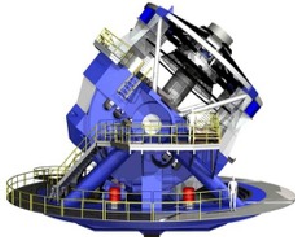


No description
LSST is a 8 m ground-based telescope project that covers the entire sky (20,000 deg²) in several photometric bands. It will be built not far from the Gémini South (8.2 m) and SOAR (4.3 m) telescopes, on the Cerro Pachón site. It is expected to provide its first images in 2018. The LSST is an extremely powerful telescope that will reveal in 15 seconds of observation, celestial objects with an apparent magnitude of 24, 15 million times less bright than the weakest object Visible to the naked eye. The original observation strategy based on very short poses will allow a real-time control of the variations of the sky, which will allow to discover the variable objects, but also to control the quality of image in an unparalleled way and to make Shape measurements much more accurate than those obtained with a conventional telescope. It is perfectly suited for observing and understanding variable objects such as supernovae, near-Earth asteroids or objects of the Kuiper belt (objects about 100 m in diameter), but also to make a sounding Very wide sky and allow a measurement of the four major probes for cosmology that are supernovae, gravitational shear, large structures and cluster measurements.
The telescope is of the Paul-Baker type with 3 mirrors; This concept allows to have a large field telescope (3.5 deg² FOV) with a very good image quality while keeping a very compact optics. The light is reflected by 3 successive mirrors before reaching the focal plane of the CCD camera. The 3.5 Giga pixel camera is equipped with six 80 cm diameter filters that rotate and are positioned alternately in front of it.
Regarding data processing, LSST will produce a quantity of data at least 10 times larger than the existing one. With a laying operation every 15 s, about 20 to 30 Terabytes per night are expected, or a total of about 30 petabytes of data. Each pose covers 10 deg². The data will be reduced in two major mirror computing centers: the National Center for Supercomputing Applications (NCSA) in Illinois and the IN2P3 Computing Center.
The LSST project is an American project whose construction decision was taken in 2011. The LSST brings together a broad collaboration including particle physicists and astronomers. The IN2P3 has a strong participation of ten laboratories, focusing mainly on the construction of the camera (detectors and mechanics) and data processing.